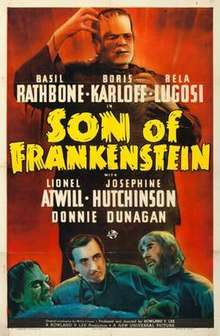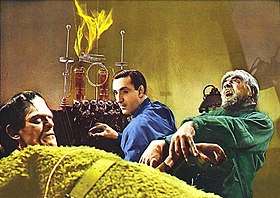Son of Frankenstein
Son of Frankenstein is a 1939 American horror film directed by Rowland V. Lee, and is the third entry in Universal Studios' Frankenstein series and the last to feature Boris Karloff as the Monster. It is also the first to feature Bela Lugosi as Ygor. The film is the sequel to James Whale's film Bride of Frankenstein (1935), and stars top-billed Basil Rathbone, Karloff, Lugosi and Lionel Atwill.
| Son of Frankenstein | |
|---|---|
 Theatrical release poster | |
| Directed by | Rowland V. Lee |
| Produced by | Rowland V. Lee |
| Screenplay by | Wyllis Cooper |
| Based on | Frankenstein by Mary Shelley |
| Starring | |
| Music by | Frank Skinner |
| Cinematography | George Robinson |
| Edited by | Ted J. Kent |
Production company | |
| Distributed by | Universal Pictures |
Release date |
|
Running time | 99 minutes |
| Country | United States |
| Language | English |
| Budget | $420,000[1][2] |
The film was a reaction to the successful re-release of Universal's earliest sound horror films, Dracula (1931) with Lugosi and Frankenstein with Karloff as a double-feature in 1938.[3] Universal's declining horror output was revitalized with the enormously successful Son of Frankenstein, in which the studio cast both stars.
Plot
Baron Wolf von Frankenstein (Basil Rathbone), son of Henry Frankenstein, relocates his wife Elsa (Josephine Hutchinson) and their young son Peter (Donnie Dunagan) to the family castle. Wolf wants to redeem his father's reputation, but finds that such a feat will be harder than he thought after he encounters hostility from the villagers, who resent him for the destruction his father's monster wreaked years before. Aside from his family, Wolf's only friend is the local police Inspector Krogh (Lionel Atwill) who bears an artificial arm, his real arm having been "ripped out by the roots" in an encounter with the Monster as a child.
While investigating his father's castle, Wolf meets Ygor (Bela Lugosi), a demented blacksmith who has survived a hanging for graverobbing and has a deformed neck as a result. Wolf finds the Monster's comatose body in the crypt where his grandfather and father were buried; his father's sarcophagus bears the phrase "Heinrich von Frankenstein: Maker of Monsters" written in chalk. He decides to revive the Monster to prove his father was right, and to restore honor to his family. Wolf uses the torch to scratch out the word "Monsters" on the casket and write "Men" beneath it.
When the Monster (Boris Karloff) is revived, it only responds to Ygor's commands and commits a series of murders; the victims were all jurors at Ygor's trial. Wolf discovers this and confronts Ygor. Wolf shoots Ygor and apparently kills him. The Monster abducts Wolf's son as revenge, but cannot bring himself to kill the child. Krogh and Wolf pursue the Monster to the nearby laboratory, where a struggle ensues, during which the Monster tears out Krogh's false arm. Wolf swings on a rope and knocks the Monster into a molten sulphur pit under the laboratory, saving his son.
Wolf leaves the keys to Frankenstein's castle to the villagers. The film ends with the village turning out to cheer the Frankenstein family as they leave by train.
Cast
- Basil Rathbone as Baron Wolf von Frankenstein
- Boris Karloff as The Monster
- Bela Lugosi as Ygor
- Lionel Atwill as Inspector Krogh
- Josephine Hutchinson as Elsa von Frankenstein
- Donnie Dunagan as Peter von Frankenstein
- Emma Dunn as Amelia
- Edgar Norton as Thomas Benson
- Perry Ivins as Fritz
- Lawrence Grant as Burgomaster
- Lionel Belmore as Emil Lang
- Michael Mark as Ewald Neumüller
- Caroline Frances Cooke as Mrs. Neumüller
- Gustav von Seyffertitz as Burgher
- Lorimer Johnston as Burgher
- Tom Ricketts as Burgher
- Ward Bond as Gendarme at Gate (uncredited)
- Harry Cording as Bearded Gendarme (uncredited)
Production

After the ousting of the Laemmles from Universal and the British embargo on American horror films in 1936, Karloff and Lugosi found themselves in a career slump. For two years, horror films were out of favor at Universal Studios. On April 5, 1938, a nearly bankrupt theater in Los Angeles staged a desperate stunt by showing Frankenstein, Dracula and King Kong as a triple feature. The impressive box office results led to similarly successful revivals nationwide. Universal soon decided to make a big-budget Frankenstein sequel.
As director James Whale was similarly in a slump and did not wish to make any more horror films, Universal selected Rowland V. Lee to direct Son of Frankenstein. Lee's film explores dramatic themes: family, security, isolation, responsibility and father-son relationships.
Son of Frankenstein marks changes in the Monster's character from Bride of Frankenstein. The Monster is duller and no longer speaks, explained by being injured by a lightning strike. The monster also wore a giant fur vest, not seen in the first two Frankenstein films, perhaps to add color to his appearance when the film was planned to be shot in color. He is fond of Ygor and obeys his orders. The Monster shows humanity in three scenes: first when he is disturbed by his image in a mirror, especially when compared to the Baron. Next, when he discovers Ygor's body, letting out a powerful scream, and later when he contemplates killing Peter but changes his mind. While the first two films were clearly set in the 1900s, this film appears to take place in the 1930s, judging by the appearance of a modern automobile.
Peter Lorre was originally cast as Baron Wolf von Frankenstein, but he had to leave the production when he became ill. Replacing Lorre was Basil Rathbone, who had scored a major triumph as Sir Guy of Gisbourne in The Adventures of Robin Hood, released the previous year.
According to the documentary Universal Horror (1998), the film was intended to be shot in color and some Technicolor test footage was filmed, but for artistic or budgetary reasons the plan was abandoned. No color test footage is known to survive, but a clip from a Kodachrome color home movie filmed at the studio and showing Boris Karloff in the green monster makeup, clowning around with makeup artist Jack Pierce, is included in the same documentary.
Release and reception
The film was commercially successful and helped return Universal Studios to profitability.[4] On the review aggregation website Rotten Tomatoes, the film has an approval rating of 91%, based on 23 reviews. The site's critical consensus reads: "Boris Karloff's final appearance as the Monster is a fitting farewell before the series descended into self-parody".[5]
The New York Times reported that the film could be considered "the silliest picture ever made", yet implements "a very shrewd silliness, perpetrated by a good director in the best traditions of cinematic horror, so that even while you laugh at its nonsense you may be struck with the notion that perhaps that's as good a way of enjoying oneself at a movie as any".[6] In a Variety review, the film was noted as being "well mounted, nicely directed, and includes [a] cast of capable artists".[7]
Jim Hoberman of The Village Voice praised Lugosi's performance as Ygor, writing that he "pretty much steals the movie in his last really juicy role".[8] In a contemporary review, the Monthly Film Bulletin stated that "since the whole atmosphere of the film is so far removed from everyday reality it is impossible to take the horrors very seriously", though noting that for a film "of its kind, however, the production is good and of a high technical quality", and praised the performances of Rathbone and Atwill.[9]
After the phenomenal success of Son of Frankenstein, Karloff decided not to return to the role of the Monster, feeling that the character was becoming the butt of jokes. Also Son of Frankenstein marked the final "A" production of Universal's Frankenstein films, which later went to "B" films, beginning with The Ghost of Frankenstein (1942) in which Lon Chaney, Jr. took over the role of the Monster and Lugosi returned as Ygor. Lugosi himself would go on to play the Monster in Frankenstein Meets the Wolf Man (1943), while Karloff would return to the franchise as another character in House of Frankenstein (1944).
References
- Michael Brunas, John Brunas & Tom Weaver, Universal Horrors: The Studios Classic Films, 1931–46, McFarland, 1990 p184
- Dick, Bernard K. (2015). City of Dreams: The Making and Remaking of Universal Pictures. University Press of Kentucky. p. 117.
- "Revival of the Undead". New York Times. October 16, 1938. p. 160.
- Stephen Jacobs, Boris Karloff: More Than a Monster, Tomahawk Press 2011 p 240-241
- "Son of Frankenstein (1939)". Rotten Tomatoes. Retrieved August 20, 2017.
- "THE SCREEN; 'Son of Frankenstein,' With Boris Karloff, Seen at the Rivoli; New Soviet Film at the Cameo At the Cameo". The New York Times. January 30, 1939. Archived from the original on August 20, 2017. Retrieved August 20, 2017.
- "Review: 'Son of Frankenstein'". Variety. December 31, 1938. Retrieved August 20, 2017.
- "Son of Frankenstein". The Village Voice. May 25, 2011. Archived from the original on August 20, 2017. Retrieved August 20, 2017.
- A.P. (1939). "Son of Frankenstein". Monthly Film Bulletin. Vol. 6 no. 61. British Film Institute. p. 21.
External links
| Wikiquote has quotations related to: Son of Frankenstein |